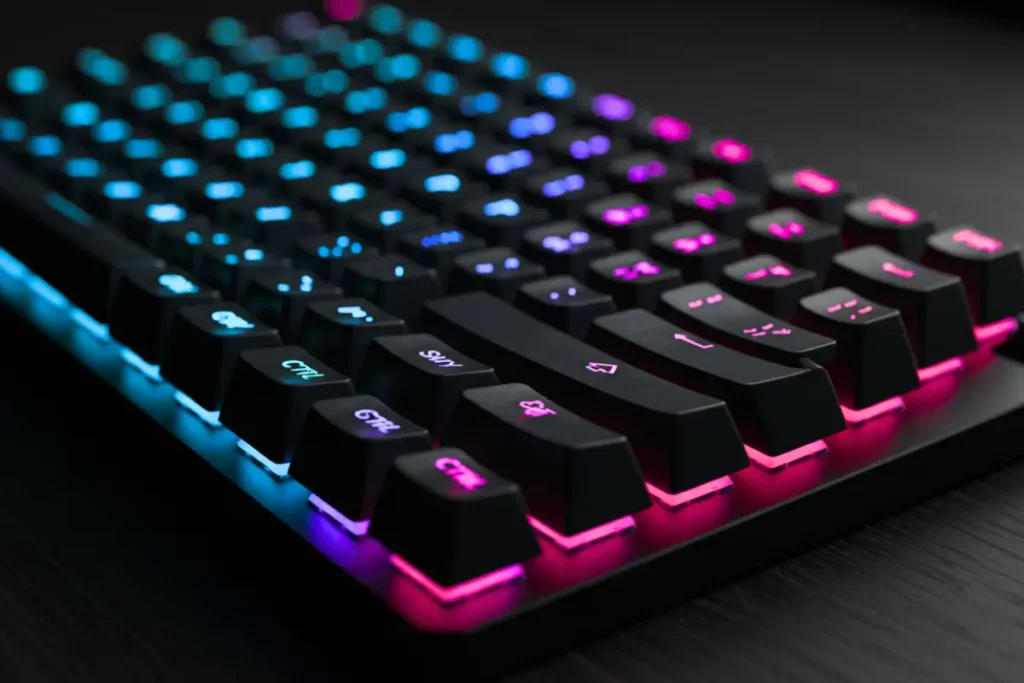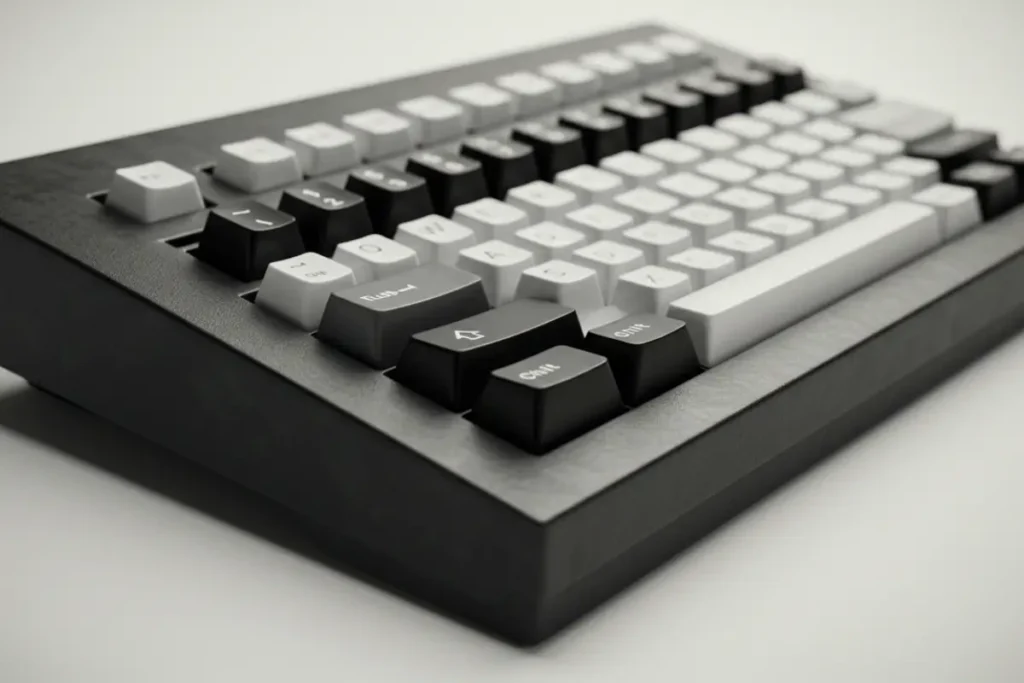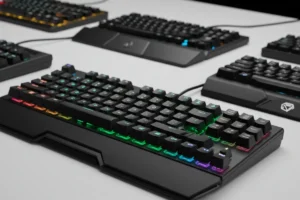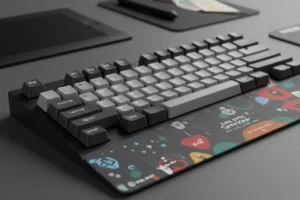Hey there, keyboard enthusiasts! 👋 Ever stumbled upon a keyboard so baffling that you questioned its very existence? As someone deeply immersed in the world of keyboards, Have seen my fair share of design missteps. Today, let’s embark on a journey through the most infamous keyboard blunders that somehow made it to market. Trust me, some of these are so perplexing, they’ll leave you wondering, “What were they thinking?” 😅

🧱 1. Commodore 64 (1982) – The Icon with a Flawed Typing Experience
Ah, the Commodore 64—a legend in the computing world. But let’s be real: its keyboard was a nightmare. The keys were stiff, unresponsive, and felt like typing on bricks.
Why It Failed:
- Poor Tactile Feedback: Typing felt more like a workout than a seamless experience.
- Inconsistent Key Sizes: Some keys were oddly sized, leading to frequent typos.
- Lack of Ergonomics: Extended typing sessions? Prepare for sore fingers.
Despite its popularity, the C64’s keyboard design was a significant drawback. It’s a classic case of form over function.
🧁 2. Apple Butterfly Keyboard (2015–2019) – Sleek Design, Fragile Mechanism
Apple aimed for innovation with its butterfly keyboard, but it backfired spectacularly. Users reported keys sticking, repeating, or not registering at all.
Why It Failed:
- Fragile Mechanism: The butterfly switches were prone to dust and debris.
- High Repair Costs: Fixing a single key often meant replacing the entire keyboard.
- User Frustration: Typing became a gamble—would the key work or not?
Apple eventually settled a $50 million lawsuit over this design flaw. A stark reminder that innovation should never compromise usability.
🧠 3. IBM PCjr Keyboard (1984) – The “Chiclet” Catastrophe
IBM’s attempt to create a user-friendly home computer led to the PCjr, but its keyboard was a disaster. The “chiclet” keys were unresponsive and uncomfortable.
Why It Failed:
- Unresponsive Keys: Typing required excessive force.
- Poor Layout: Keys were oddly spaced, leading to frequent errors.
- Negative Reception: Users and critics alike panned the design.
The PCjr’s keyboard was so poorly received that it earned the nickname “Peanut.” Ouch.
🧮 4. TI-99/4 (1979) – The Calculator Keyboard That Wasn’t
Texas Instruments’ TI-99/4 featured a keyboard that felt more like a calculator than a computer. The keys were small, stiff, and lacked tactile feedback.
Why It Failed:
- Tiny Keys: Difficult to type on, especially for users with larger hands.
- Stiff Mechanism: Required significant pressure to register keystrokes.
- Limited Functionality: Not suitable for serious typing tasks.
The TI-99/4’s keyboard was a major hindrance, overshadowing the computer’s other features.
🧬 5. Dvorak Simplified Keyboard – Efficiency Over Familiarity
Designed to increase typing efficiency, the Dvorak layout never gained widespread adoption. Users were too accustomed to QWERTY to make the switch.
Why It Failed:
- Steep Learning Curve: Retraining was time-consuming and challenging.
- Lack of Support: Few devices and software supported the layout.
- Resistance to Change: Users preferred the familiar QWERTY layout.
Despite its potential benefits, the Dvorak keyboard remains a niche choice.
🧱 6. Sinclair ZX Spectrum Keyboard (1982) – Rubber Keys, Real Problems
The ZX Spectrum’s rubber keyboard was innovative but impractical. Typing felt mushy, and the keys lacked definition.
Why It Failed:
- Poor Tactile Feedback: Keys felt indistinct and unresponsive.
- Durability Issues: The rubber degraded over time.
- Typing Fatigue: Extended use led to discomfort.
While the ZX Spectrum was a beloved computer, its keyboard left much to be desired.
🧁 7. MSX Chiclet Keyboards – A Standardized Misstep
The MSX standard led to various manufacturers producing computers with chiclet keyboards. Unfortunately, these keyboards were often subpar.
Why It Failed:
- Inconsistent Quality: Varying manufacturing standards led to unreliable keyboards.
- Uncomfortable Typing: Keys were often stiff and poorly spaced.
- Negative User Experience: Typing was more chore than pleasure.
The MSX’s keyboard issues highlighted the challenges of standardization without strict quality control.
🧠 8. Atari 400 (1979) – Membrane Misery
Atari’s 400 model featured a membrane keyboard that was nearly impossible to type on efficiently.
Why It Failed:
- Lack of Tactile Feedback: Typing felt like pressing on a flat surface.
- High Error Rate: Users frequently made mistakes due to the unresponsive keys.
- User Frustration: The keyboard was a significant barrier to productivity.
The Atari 400’s keyboard was a classic example of design prioritizing cost over usability.
🧮 9. BigKeys LX – Accessibility Over Functionality
While designed for users with motor skill difficulties, the BigKeys LX’s oversized keys made typing cumbersome for the average user.
Why It Failed:
- Bulky Design: The large keys made the keyboard unwieldy.
- Limited Appeal: Not suitable for general use.
- Reduced Typing Speed: The design hindered fast typing.
Though well-intentioned, the BigKeys LX wasn’t practical for most users.
🧬 10. Safetype Keyboard – Ergonomics Gone Awry
The Safetype keyboard aimed to reduce strain by positioning keys vertically. However, it introduced a steep learning curve and awkward typing posture.
Why It Failed:
- Complex Layout: Users struggled to adapt to the vertical key arrangement.
- Awkward Posture: Typing required unnatural hand positions.
- Limited Adoption: Few were willing to invest the time to learn it.
The Safetype serves as a reminder that ergonomic designs must balance innovation with practicality.

📊 Comparison Table: Keyboard Fails at a Glance
| Keyboard | Year | Main Issue | User Feedback |
|---|---|---|---|
| Commodore 64 | 1982 | Stiff keys | Negative |
| Apple Butterfly | 2015 | Fragile mechanism | Highly negative |
| IBM PCjr | 1984 | Unresponsive chiclet keys | Poor |
| TI-99/4 | 1979 | Calculator-style keys | Negative |
| Dvorak Layout | 1936 | Steep learning curve | Mixed |
| ZX Spectrum | 1982 | Mushy rubber keys | Negative |
| MSX Chiclet Keyboards | 1983 | Inconsistent quality | Negative |
| Atari 400 | 1979 | Membrane keyboard | Poor |
| BigKeys LX | 2000 | Oversized keys | Mixed |
| Safetype Keyboard | 2002 | Vertical key layout | Negative |
See More
- SteelSeries vs Logitech: Best Gaming Keyboard Showdown
- Custom Keyboard Layouts and Macros for Creatives
- Keyboard Sound Test Trends: Why Everyone Is Obsessed
🤔 Final Thoughts
Reflecting on these keyboard missteps, it’s clear that innovation without user-centric design can lead to failure. As a keyboard aficionado, I appreciate the lessons these examples provide. They remind us that while pushing boundaries is essential, understanding user needs is paramount.
If you’re interested in exploring more about keyboard designs and innovations, check out our article on The Most Unique Keyboards Ever Created.
If you enjoyed this deep dive into keyboard history, don’t forget to share this article with fellow tech enthusiasts! And hey, drop a comment below—what’s the worst keyboard you’ve ever used? Let’s chat! 💬
🎮 Join Our Discord Community!
Are you passionate about keyboards, gaming, and tech? Come hang out with fellow enthusiasts, ask questions, share your setup, and stay updated with our latest content!
👉 Join Now

